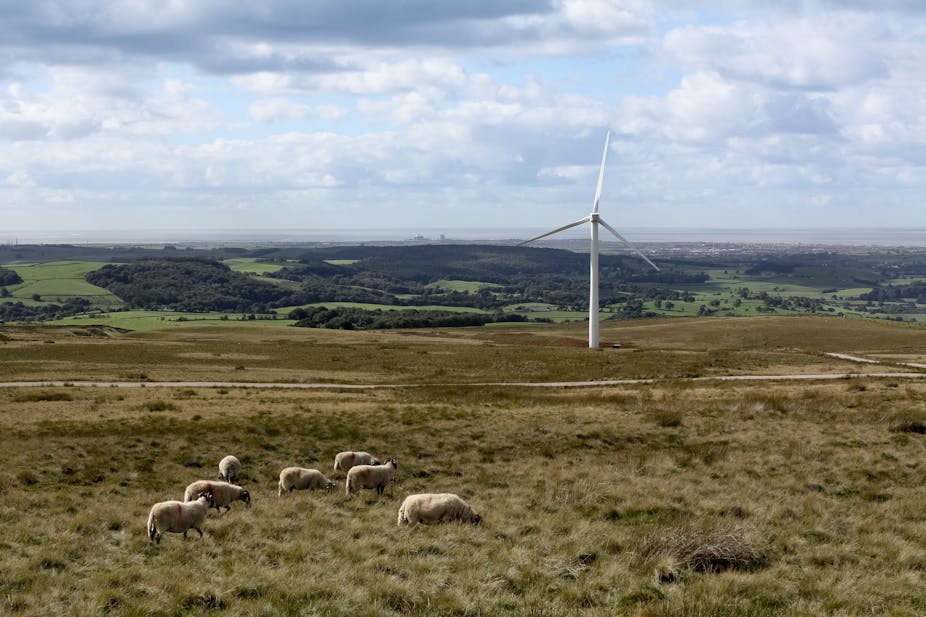The government claims its new package of measures for wind farm development will give communities greater say over on-shore developments. The trouble is, one set of measures is giving them more scope to say “no” and another set is encouraging them to say “yes”.
In the “no” camp, planning policy is to be changed to give greater weight to the landscape and visual impact of wind farms. In the “yes” camp is a move to increase the benefits that wind energy developers provide to communities. Quite what the combined effects will be – for rates of wind energy development, or community attitudes towards wind farms – is difficult to call.
Traditionally, governments have held the view that providing more benefits to communities facing wind farm developments will increase support and expedite planning consent. The press releases accompanying the recent announcements are much more coy on this point – and well they might be, because the evidence that community benefits actually change public opinion is decidedly mixed, with analysts often left relying on specific case-studies.
But the ideas in this package are not wholly new, which allows us to review what is proposed against experience to date.
What’s £4,000 between friends?
In practice, most developers of on-shore wind farms are already providing benefits to nearby communities, typically through a fund calculated as a sum per megawatt (MW) of installed capacity, each year, for the life of the wind farm. The funds have usually been channelled through some community body to be spent on local good causes, community infrastructure or sustainable energy measures. Now the government is trying to “up” the industry minimum from £1,000/MW per year to £5,000.
However, many companies, such as SSE Renewables are already offering £5,000/MW or more – though admittedly this is more common in Wales and Scotland, where sites are windier and larger than in England.
The issue is that the mechanism by which this improved offer is to be encouraged is through the industry’s own community benefit protocol. Government cannot mandate that it changes the protocol, and developers do not have to follow it anyway.
Caution to the wind
Even if the level of community benefits does increase, we are still left with a big imponderable – in how many instances will this actually change local opinion towards wind? Here one should expect much variation between places and projects.
In some places the dominant local view is simply that the landscape costs of large wind turbines cannot rightly be traded off for financial payments, and that the places threatened should be protected intact from such developments. This would be true in most of our protected landscapes (already avoided by wind farm developers) and much of rural southern England. Upping community benefit payments is unlikely to change much here.
In other places, local communities were already supportive (or acquiescent) towards wind energy, and although higher community benefits may achieve a more just balance of costs and benefits, planning outcomes again will be little changed.
So we should only expect different results in those places where local planning politics is dominated by people who teeter on the fence: they start with ambivalent attitudes, they are at risk of becoming objectors, but higher levels of community benefits turn them into potential supporters. What no one can say with any certainty is how many wind farm locations fall into this third category.
Changing minds
Can we be any more certain about the effects of the government’s changes to planning processes? The proposal to improve consultation with local communities for on-shore wind applications may have positive effects. Research, such as Patrick Devine-Wright’s work in his book Renewable Energy and the Public, regularly shows how perceptions that decision-making processes are unfair can exacerbate opposition.
The proposal to give greater weight to landscape and visual impacts of wind power vis a vis expanding renewable energy is arguably the most significant proposal in the whole package.
This is partly because planning policy has teeth; but also because it helps those opposing wind farms translate their oppositional attitudes into actual planning refusals. The community benefits measure only influences attitudes; whether people persuaded by the benefits will engage in the planning process is a separate question.
The power of bills
The dark horse in this battle of conflicting instruments is a new form of community benefit that offers people who live near wind farms cheaper electricity.
For years this was the holy grail of the community benefits world. Wind energy developers often claimed to encounter residents asking “why can’t you give us a cheaper electricity?”, but actually doing it foundered on the complexities of the UK’s private electricity market. But the company RES has been rolling out a system that works by giving local communities reductions on their electricity bills, and claims much local support in locations where it has been tried.
The government’s announcements have been positive about this idea, alongside wider encouragement to communities and developers to work together to decide how benefits should be used. Whether it affects public responses to on-shore wind is one to watch.
So too is which form of benefits communities prefer – reductions on individual electricity bills, or funds to invest in collective community projects? If nothing else, this shift in policy for wind farms will be very revealing about the sense of community that prevails in the English countryside.

